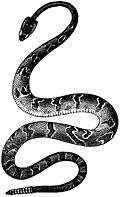Definify.com
Definition 2025
虫
虫
See also: 蟲
Translingual
| Stroke order | |||
|---|---|---|---|

| |||
Pictogram (象形) : a snake.
The character originally represented a type of venomous snake, while the derivative 蟲 represented worms and insects (or insect-like things). 虫 eventually came to represent worms and insects as well, and the character 虺 was created to represent the original meaning.
虫 is Simplified from 蟲 (elimination of 䖵) and 虫 is the simplified form of 蜀 that is used only as a character component.
Han character
虫 (radical 142 虫+0, 6 strokes, cangjie input 中一戈 (LMI), four-corner 50136)
- Kangxi radical #142, ⾍ (“insect”).
References
- KangXi: page 1076, character 19
- Dai Kanwa Jiten: character 32804
- Dae Jaweon: page 1545, character 7
- Hanyu Da Zidian: volume 4, page 2833, character 1
- Unihan data for U+866B
Descendants
強, 虹, 蚌, 蚯, 蛐, 蛻, 蜀, 蜂, 蜇, 蜥, 蝗, 蝠, 蝴, 蟄, 蟬, 蟲, 蟹, 蠍, 蠟, 蠣, 蠶
Chinese
Etymology 1
| For pronunciation and definitions of 虫 – see 蟲 (“insect”). (This character, 虫, is the simplified form of 蟲.) |
Notes:
|
Etymology 2
| For pronunciation and definitions of 虫 – see 虺 (“venomous snake”). (This character, 虫, is an ancient form of 虺.) |
Japanese
Kanji
虫
(grade 1 “Kyōiku” kanji, shinjitai kanji, kyūjitai form 蟲)
Readings
Compounds
Compounds
|
虫
Readings
Etymology
| Kanji in this term |
|---|
| 虫 |
|
むし Grade: 1 |
| kun'yomi |
Pronunciation
Noun
虫 (shinjitai kanji, kyūjitai kanji 蟲, hiragana むし, katakana ムシ, romaji mushi)



